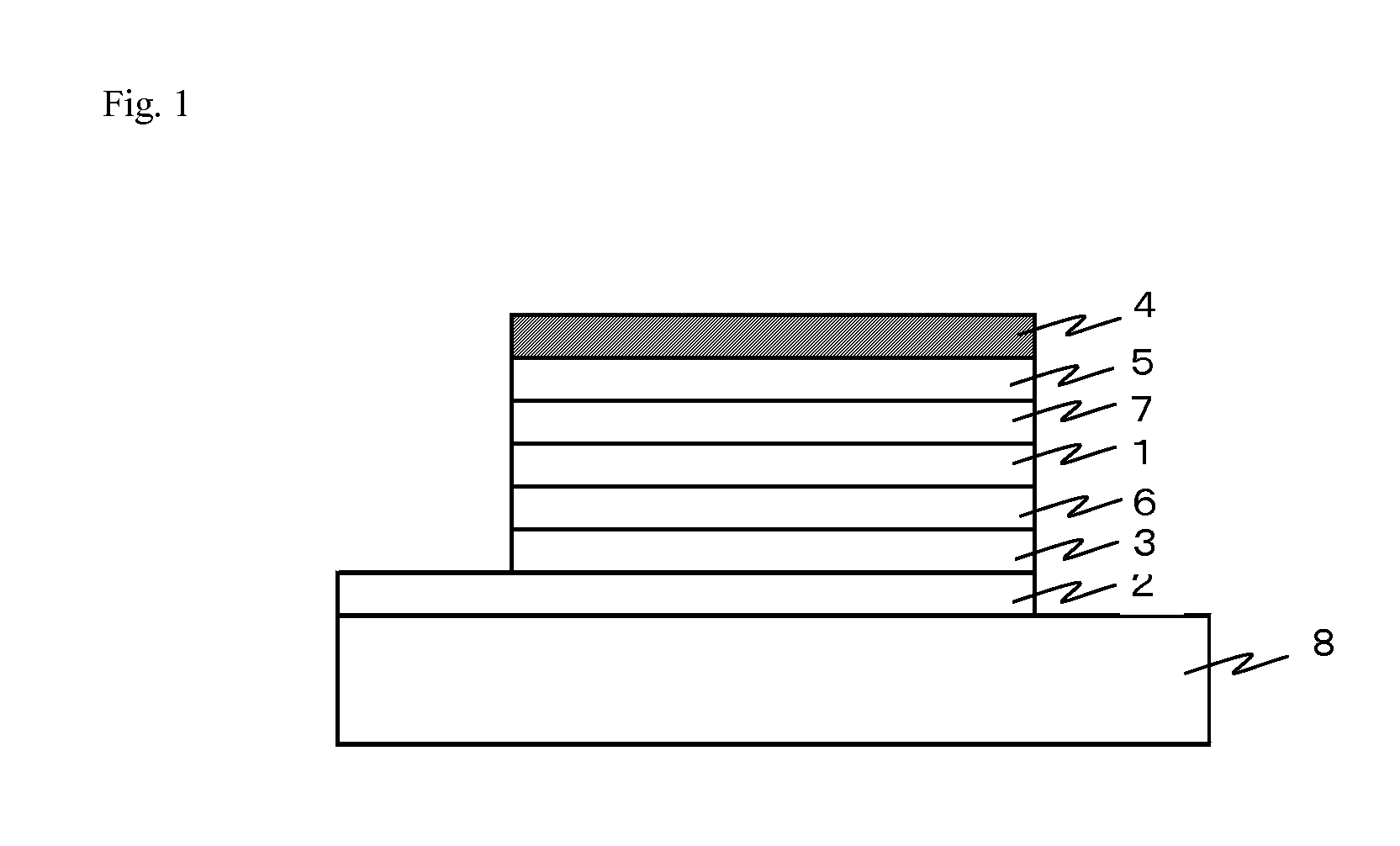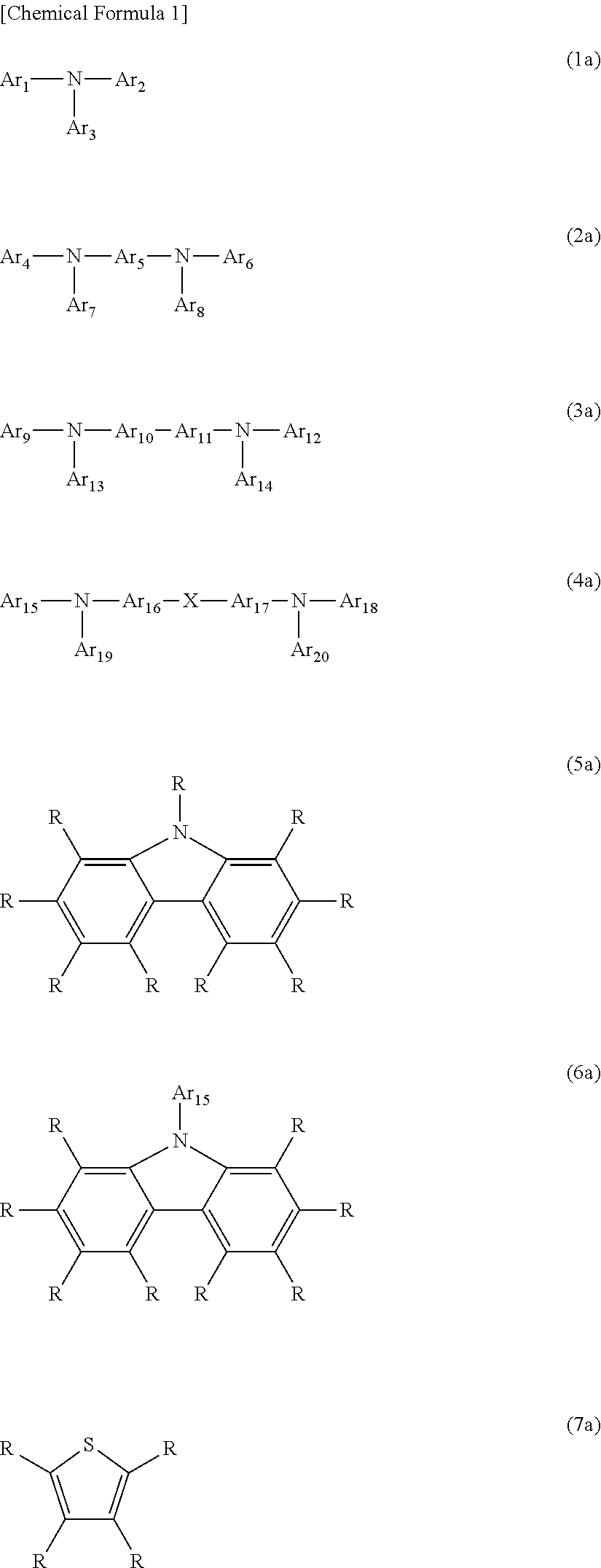Material for organic electronics, organic electronic element, organic electroluminescent element, display element using organic electroluminescent element, illuminating device, and display device
a technology of electronic elements and materials, applied in the direction of thermoelectric device junction materials, conductive materials, solid-state devices, etc., can solve the problems of short service life of elements, difficult to eliminate water, and low light emission efficiency, and achieve stable driving for a long time, low temperature curing, and low voltage
- Summary
- Abstract
- Description
- Claims
- Application Information
AI Technical Summary
Benefits of technology
Problems solved by technology
Method used
Image
Examples
first embodiment
[Organic EL Element of First Embodiment]
[0110]The organic EL element of the first embodiment of the present invention is characterized by having a layer formed from the material for organic electronics of the present invention as described above (hereinafter, also referred to as a polymerized layer). The organic EL element of the present invention is not particularly limited as long as it includes a light emitting layer, a polymerized layer, an anode, a cathode, and a substrate, and the organic EL element may also have other layers such as a hole injection layer, an electron injection layer, a hole transport layer, and an electron transport layer. The various layers will be explained in detail below.
[Light Emitting Layer]
[0111]The material used in the light emitting layer may be a low molecular weight compound, or may be a polymer or an oligomer, and a dendrimer or the like can also be used. Examples of a low molecular weight compound using fluorescent light emission include perylen...
second embodiment
[Organic EL Element of Second Embodiment]
[0136]The organic EL element of the second embodiment of the present invention has a multilayer structure, and is characterized in that two adjacent layers in the multilayer structure are formed by a coating method, respectively using a mixture containing a hole transporting compound having a polymerizable substituent, and the hole transporting compounds are respectively polymerized. Hereinafter, similarly to the first embodiment, a layer which is formed by a coating method using a mixture containing a hole transporting compound having a polymerizable substituent, and has the solubility modified by polymerizing the hole transporting compound, will be referred to as a polymerized layer.
[0137]The organic electroluminescent element of the second embodiment of the present invention has a multilayer structure, but the various layers in the multilayer structure are not particularly limited as long as the multilayer structure has a light emitting la...
example 1
(Evaluation of Polymerizability)
[0186]A coating solution prepared by mixing a toluene solution (400 μl) of a compound 1 (4.5 mg) shown below and an ethyl acetate solution (100 μl) of an ionic compound 1 (0.45 g) shown below, was spin coated on a quartz plate at 3000 rpm. Subsequently, the coated quartz plate was heated on a hot plate at 120° C. for 10 minutes to carry out a polymerization reaction. After the heating, the quartz plate was immersed for one minute in a solvent mixture of toluene:ethyl acetate (4:1), and was washed. The residual film ratio was measured from the ratio of the absorbances (Abs) of the maximum absorption (λmax) in the UV-vis spectrum obtained before and after washing.
[0187]Before washing: λmax=383 nm, Abs=0.229
[0188]After washing: λmax=383 nm, Abs=0.228
Residual film ratio(%)=Abs after washing / Abs before washing×100=0.228 / 0.229×100=99.6
PUM
| Property | Measurement | Unit |
|---|---|---|
| temperature | aaaaa | aaaaa |
| temperature | aaaaa | aaaaa |
| temperature | aaaaa | aaaaa |
Abstract
Description
Claims
Application Information
 Login to View More
Login to View More - R&D
- Intellectual Property
- Life Sciences
- Materials
- Tech Scout
- Unparalleled Data Quality
- Higher Quality Content
- 60% Fewer Hallucinations
Browse by: Latest US Patents, China's latest patents, Technical Efficacy Thesaurus, Application Domain, Technology Topic, Popular Technical Reports.
© 2025 PatSnap. All rights reserved.Legal|Privacy policy|Modern Slavery Act Transparency Statement|Sitemap|About US| Contact US: help@patsnap.com



